Membrane–Fresnel Diffractive Lenses with High-Optical Quality and High-Thermal Stability
Abstract
:1. Introduction
2. Imaging Theories of M-FDL
3. Fabrication of M-FDL
3.1. Preparation of the Ultrathin Flexible PI Membrane
3.2. Fixation of the Ultrathin Flexible PI Membrane with High-Thermal Stability
3.3. High-Precision Fabrication of M-FDL with High Optical Quality
4. Results and Discussion
5. Conclusions
Author Contributions
Funding
Institutional Review Board Statement
Informed Consent Statement
Data Availability Statement
Conflicts of Interest
References
- Liu, T.; Zhou, R.S. Development overview on GEO high resolution optical imaging system. Spacecr. Eng. 2017, 26, 91–100. [Google Scholar]
- Yu, Q.Y.; Qu, S.H. Realization of high-resolution visible earth observation on geostationary earth orbit. Chin. J. Opt. Appl. Opt. 2008, 1, 1–12. [Google Scholar]
- Kevin, L.W.; Robert, G.M.; Jeanette, L.D.; Robert, K. Large Aperture Diffractive Receiver for Deep Space Optical Communications. In Applications of Lasers for Sensing and Free Space Communications; Optica Publishing Group: Washington, DC, USA, 2015. [Google Scholar]
- Jiao, J.C.; Su, Y.; Wang, B.H.; Wang, C.; Zhang, Y.; Jin, J.G. Development and application of GEO membrane based diffraction optical imaging system. Space Int. 2016, 6, 49–55. [Google Scholar]
- Liu, T. Research on the development of space-based diffraction imaging system and related technologies. Space Int. 2014, 8, 46–52. [Google Scholar]
- Geoff, A. Membrane photon sieve telescopes. Appl. Opt. 2010, 49, 6391–6394. [Google Scholar]
- Andersen, G.; Asmolov, O.; Dearborn, M.E.; Matthew, M. FalconSAT-7: A membrane photon sieve CubeSat solar telescope. In Proceedings of the Space Telescopes and Instrumentation 2012: Optical, Infrared, and Millimeter Wave, Amsterdam, The Netherlands, 1–6 July 2012; SPIE—The International Society for Optical Engineering: Bellingham, DC, USA, 2012. [Google Scholar]
- Early, J.T.; Hyde, R.; Baron, R.L. Twenty-meter space telescope based on diffractive Fresnel lens. In Proceedings of the UV/Optical/IR Space Telescopes: Innovative Technologies and Concepts, San Diego, CA, USA, 3–5 August 2003; SPIE—The International Society for Optical Engineering: Bellingham, DC, USA, 2004. [Google Scholar]
- Atcheson, P.D.; Stewart, C.; Domber, J.; Whiteaker, K.; Cole, J. MOIRE: Initial Demonstration of a Transmissive Diffractive Membrane Optic for Large Lightweight Optical Telescopes. In Proceedings of the Space Telescopes and Instrumentation 2012: Optical, Infrared, and Millimeter Wave, Amsterdam, The Netherlands, 1–6 July 2012; SPIE—The International Society for Optical Engineering: Bellingham, DC, USA, 2012. [Google Scholar]
- Britten, J.A.; Dixit, S.N.; Debruyckere, M.; Daniel, S.; James, H.; Brandon, F.; Garrett, P.; Brian, P.; Paul, D.A.; Jeanette, L.D.; et al. Large-aperture fast multilevel Fresnel zone lenses in glass and ultrathin polymer films for visible and near-infrared imaging applications. Appl. Opt. 2014, 53, 2312–2316. [Google Scholar] [CrossRef]
- Zhang, J.; Li, S.J.; Yin, G.H.; Jiao, J.C.; Liu, Z.K.; Xu, X.D.; Fu, S.J. Large-diameter membrane Fresnel diffraction elements for space telescope. Opt. Precis. Eng. 2016, 24, 1289–1296. [Google Scholar] [CrossRef]
- Zhang, J.; Li, S.J.; Yin, G.H.; Jiao, J.C.; Liu, Z.K.; Xu, X.D.; Fu, S.J. low-cost method of fabrication large-aperture, high efficiency, Fresnel diffractive membrane optic using a modified MOIRE technique. Chin. Opt. Lett. 2016, 14, 14–18. [Google Scholar]
- Liu, X.; Gong, C.C.; Fan, B.; Bian, J. High Precision Fabrication Method of Fresnel Diffractive Lenses on Ultrathin Membrane for Imaging Application. IEEE Photonics J. 2020, 12, 1–10. [Google Scholar] [CrossRef]
- Gong, C.C.; Shao, J.M.; Fan, B.; Liu, X. High precision fabrication method of diffractive lens on large aperture quartz substrate. ACTA Photonica Sin. 2020, 49, 178–187. [Google Scholar]
- Donald, W.S.; Gary, E.S. Harmonic diffractive lenses. Appl. Opt. 1995, 34, 2469–2475. [Google Scholar]
- Faklis, D.; Morris, G.M. Spectral properties of multi-order diffractive lenses. Appl. Opt. 1995, 34, 2462–2468. [Google Scholar] [CrossRef] [Green Version]
- Yang, W.; Wu, S.B.; Wang, L.H.; Fan, B.; Yang, H. Research advances and key technologies of macrostructure membrane telescope. Opto-Electron. Eng. 2017, 44, 475–482. [Google Scholar]
- Mathias, H.; Wolff, V.S.; Marc, S.; Theo, T.; Bahram, J. 3D integral imaging using diffractive Fresnel lens arrays. Opt. Express 2005, 13, 315–326. [Google Scholar]
- Sugeily, F.B.; Juan, V.M.; Oscar, M.S.; Walter, S.A. Tortuosity Index Based on Dynamic Mechanical Properties of Polyimide Foam for Aerospace Applications. Materials 2019, 12, 1851. [Google Scholar] [CrossRef] [PubMed] [Green Version]
- Yan, Y.; Mao, Y.; Li, B.; Zhou, P. Machinability of the Thermoplastic Polymers: PEEK, PI, and PMMA. Polymers 2021, 13, 69. [Google Scholar] [CrossRef]
- Tan, X.M.; Rodrigue, D. A Review on Porous Polymeric Membrane Preparation. Part II: Production Techniques with Polyethylene, Polydimethylsiloxane, Polypropylene, Polyimide, and Polytetrafluoroethylene. Polymers 2019, 11, 1310. [Google Scholar] [CrossRef] [PubMed] [Green Version]
- Mao, D.B.; Lv, G.; Gao, G.H.; Fan, B. Fabrication of polyimide films with imaging quality using a spin-coating method for potential optical applications. J. Polym. Eng. 2019, 39, 917–925. [Google Scholar] [CrossRef]
- Zhang, M.Y.; Niu, H.Q.; Wu, D.Z. Polyimide Fibers with High Strength and High Modulus: Preparation, Structures, Properties, and Applications. Macromol. Rapid Commun. 2018, 39, e1800141. [Google Scholar] [CrossRef]
- Tan, Z.; Wu, S.B.; Yang, W.; Zhai, J. Measurement of Circular Membrane Pre-stress. Eng. Plast. Appl. 2020, 48, 109–114. [Google Scholar]
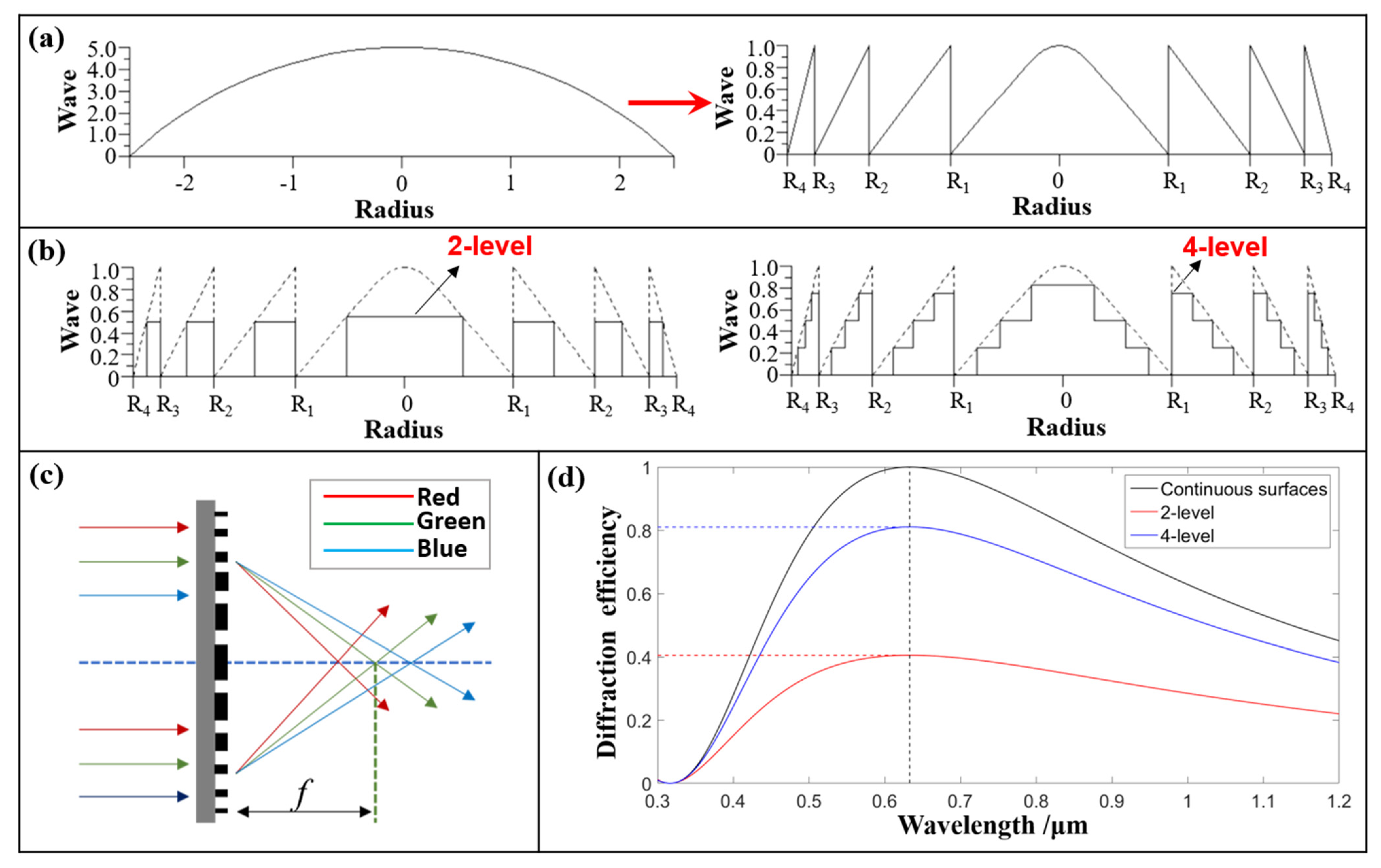
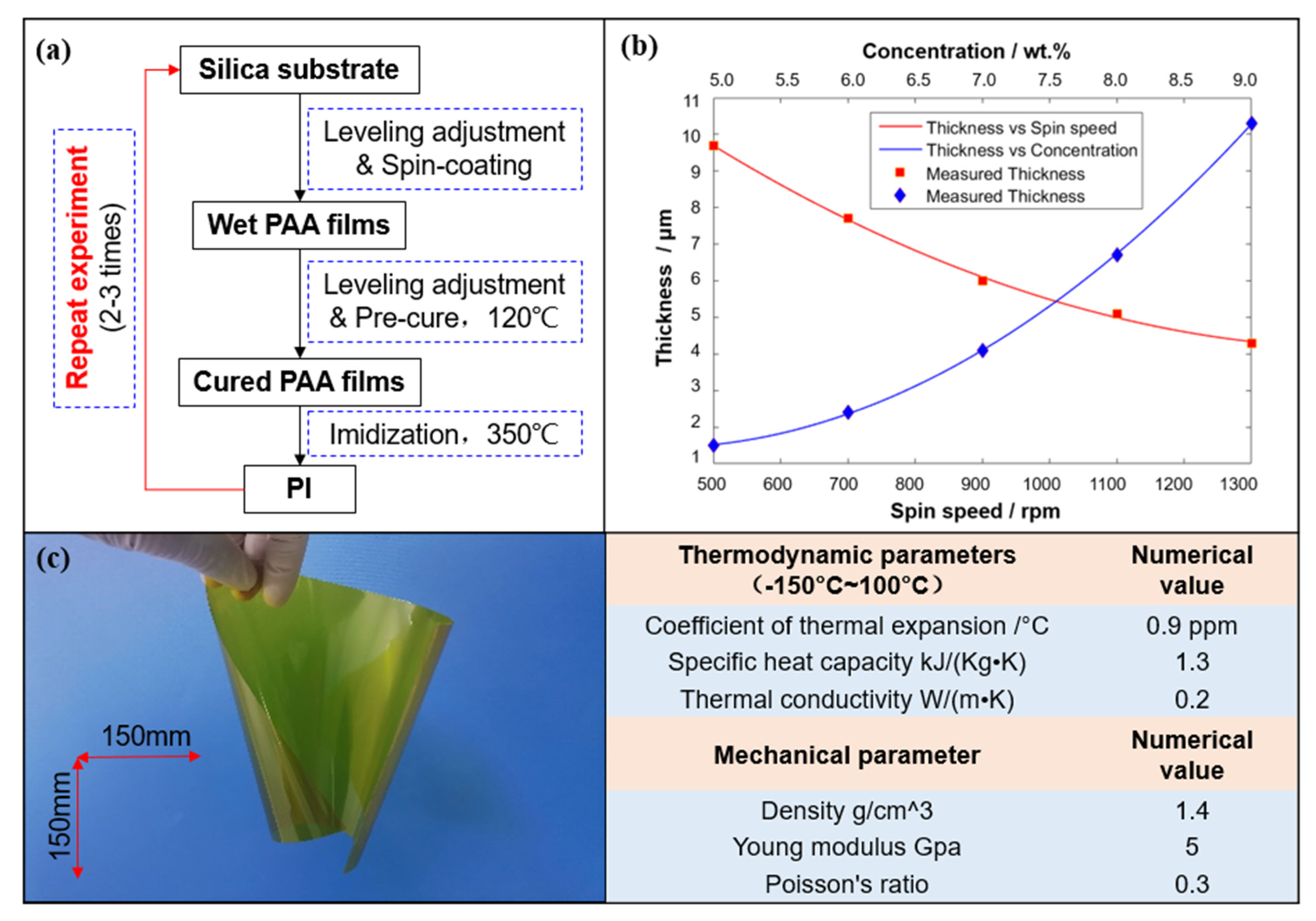
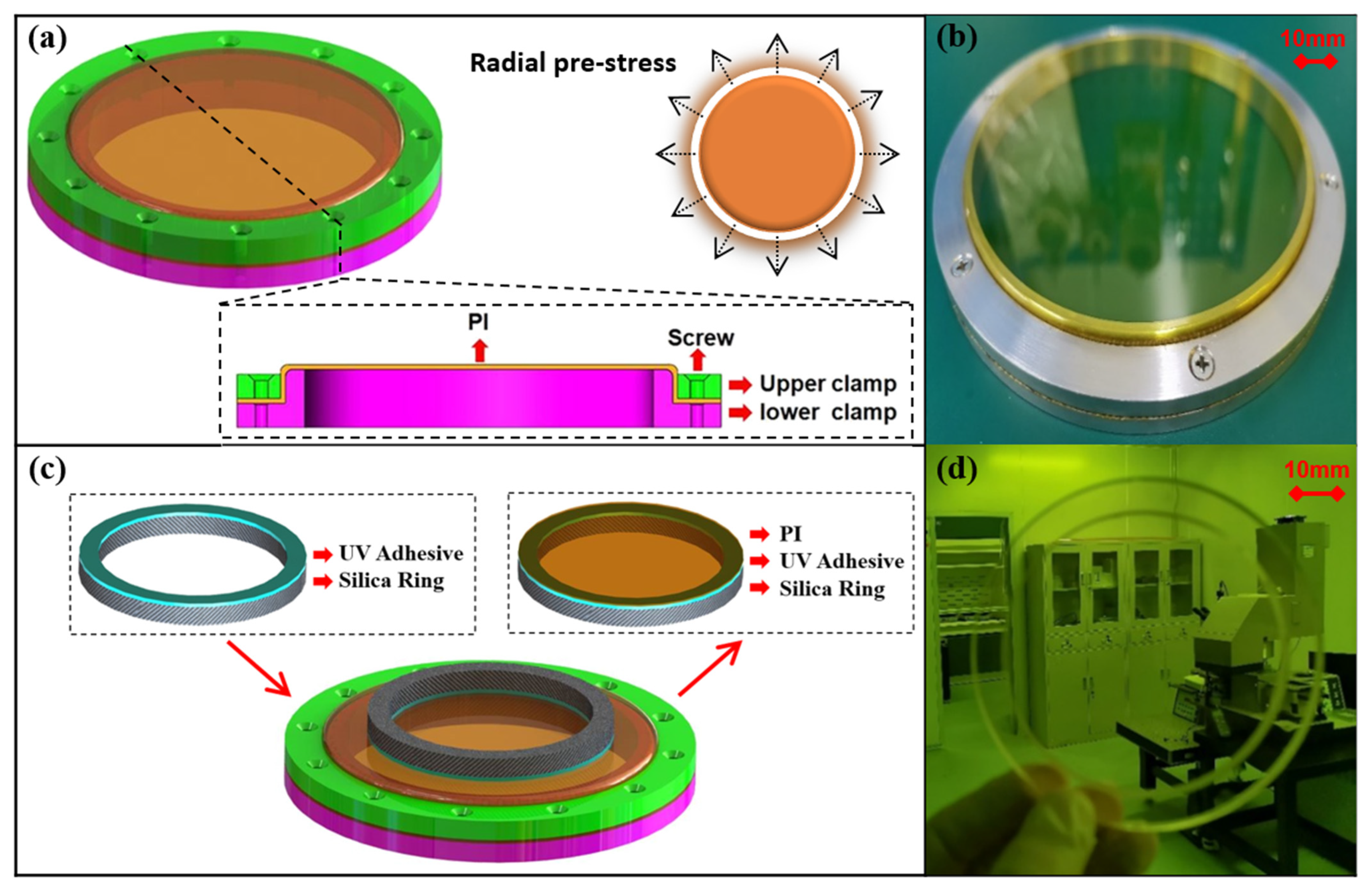

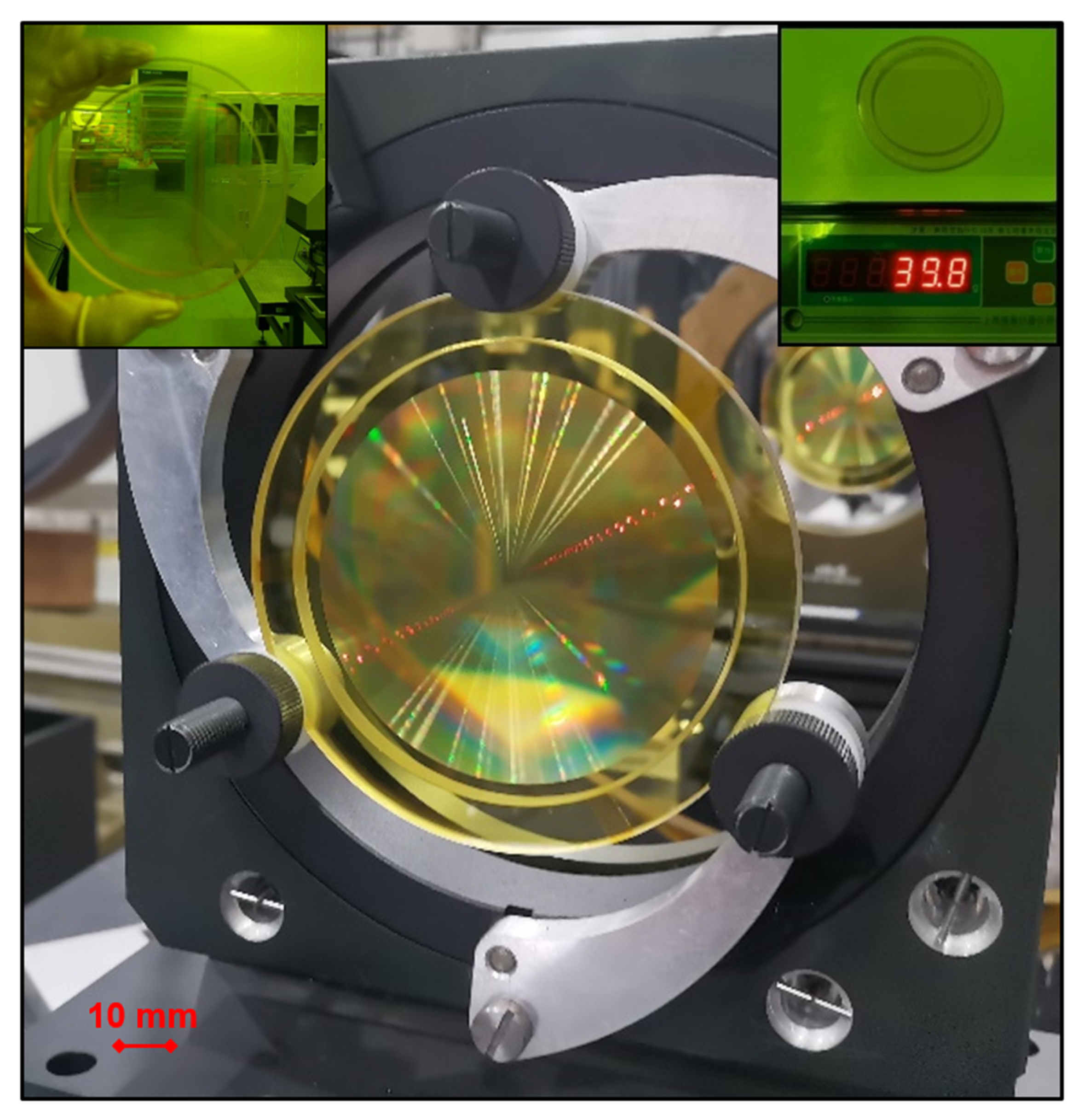
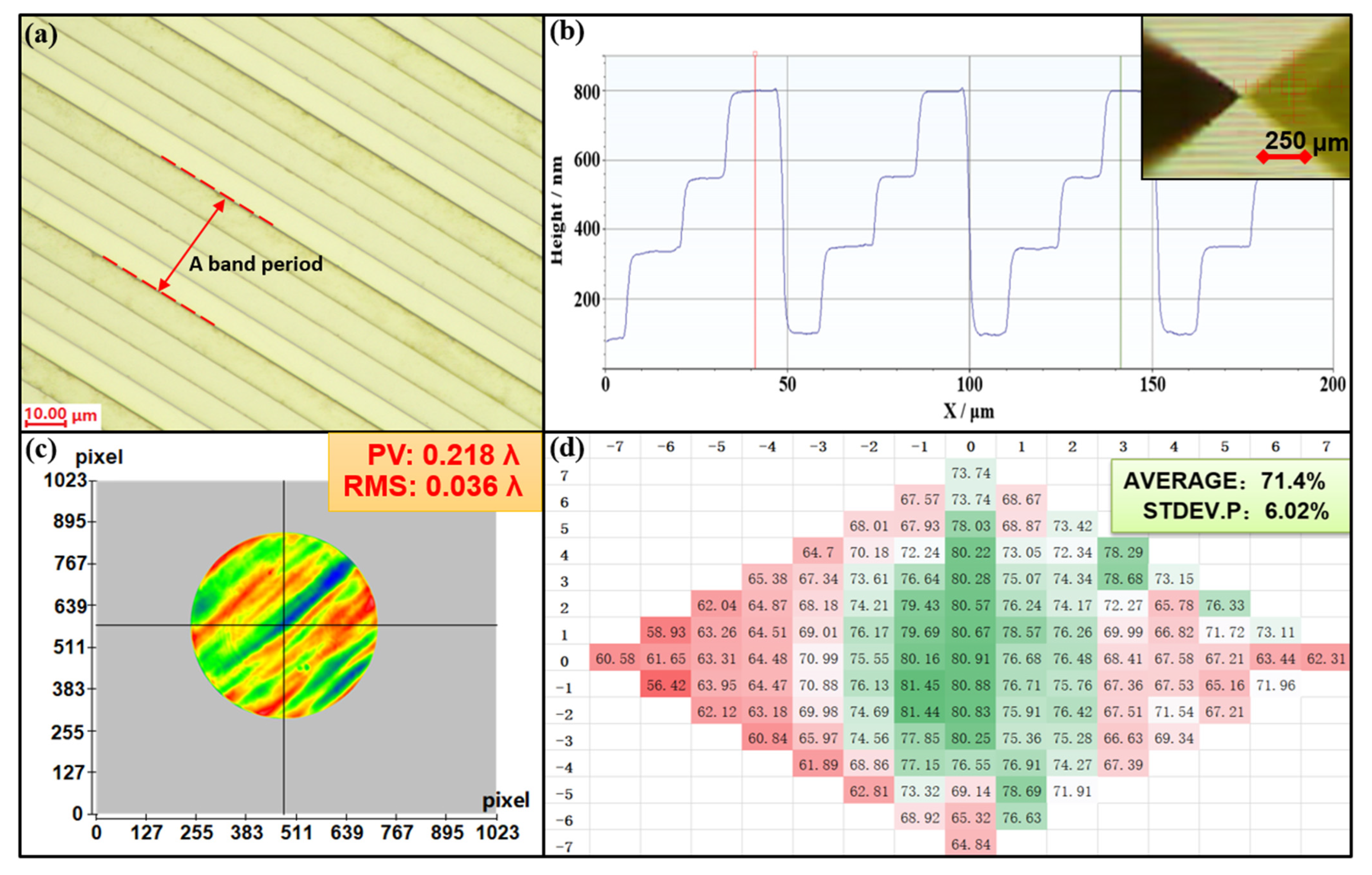
| Optical Parameters | Microstructure Parameters | ||
|---|---|---|---|
| Central wavelength | 632.8 nm | Band number | 1819 |
| Focal length | 695 mm | Critical dimension | 2.75 μm |
| F_number | 8.7 | Level height | 240 nm |
Publisher’s Note: MDPI stays neutral with regard to jurisdictional claims in published maps and institutional affiliations. |
© 2022 by the authors. Licensee MDPI, Basel, Switzerland. This article is an open access article distributed under the terms and conditions of the Creative Commons Attribution (CC BY) license (https://creativecommons.org/licenses/by/4.0/).
Share and Cite
Liu, X.; Li, M.; Li, B.; Fan, B. Membrane–Fresnel Diffractive Lenses with High-Optical Quality and High-Thermal Stability. Polymers 2022, 14, 3056. https://doi.org/10.3390/polym14153056
Liu X, Li M, Li B, Fan B. Membrane–Fresnel Diffractive Lenses with High-Optical Quality and High-Thermal Stability. Polymers. 2022; 14(15):3056. https://doi.org/10.3390/polym14153056
Chicago/Turabian StyleLiu, Xin, Min Li, Bincheng Li, and Bin Fan. 2022. "Membrane–Fresnel Diffractive Lenses with High-Optical Quality and High-Thermal Stability" Polymers 14, no. 15: 3056. https://doi.org/10.3390/polym14153056







